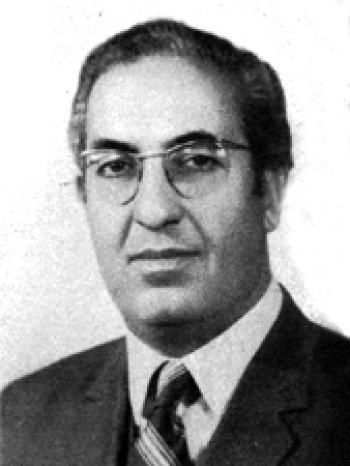Houshang Seyhoun was born on August 22, 1920 in Tehran. He lived in an environment that his family was vitally involved in music and art. From early age he was encouraged to pursue his passion for drawing. This extended to decorating the finely crafted pillars of his parental home with black charcoal lines on stark white columns and walls. After completing his early education and graduating from high school in Tehran, at the outbreak of the Second World War he was admitted to the newly established College of Fine Arts at Tehran University. His childhood passion for drawing was now extended to design and architecture. Seyhoun talent, in the next four years, was blossomed under the careful direction of his mentor and supervisor, French professor Maxime Siroux.
Shortly after Seyhoun's graduation, Iran Soviet Union Cultural Society in Tehran, which organized many cultural events, arranged for an exhibition for the works of Iranian artists. Seyhoun's graduation project was exhibited, and judges awarded him the insignia for arts from Iranian Ministry Of Culture and Arts, which he himself had designed it sometimes earlier during a contest at the college. In the year following the WWII, Seyhoun won several additional contests and prizes for his architectural designs, like the design of a monument at Tehran's Central Railway Station. Soon after, he designed the commemorative monument and mausoleum of Iranian philosopher, physician and father of modern medicine, Avicenna, in Hamadan.
In 1946 he left for France to advance his studies in cole Superieure des Beaux Arts. He studied under Professor Otello Zavaront for three years and traveled widely throughout Europe. In 1949 he completed his study and received the "Docteur d'Art". During the next 20 years he designed mausoleums for Omar Khayyam and Nader Shah, as well as completing the main complex of Iranian National Assembly, and a large educational complex in South of Tehran. During these years he lectured widely in Iran, Europe and North America and conducted numerous seminars and workshops.
In 1962 Seyhoun was appointed Dean of the School of Fine Arts and Architecture at Tehran University and immediately undertook major re-structure of the College. For the first time in 1968, he exhibited in Tehran, which featured his abstract drawing with pen and ink. At this time he became member of ICOMOS, Division of UNESCO, and served as president of Iranian Architectural Organization. During this period, he was instrumental in bringing two World Architectural Congress to Iran, one in historical Isfahan and one in Persepolis (Shiraz). In 1969, he was elected a member of the City Council for Tehran for the period of four years.
In 1972, his work was part of the large group exhibition in Amherst, Massachusetts, USA, which included the works of Salvador Dali and Pablo Picasso. Two years later, he exhibited in Paris with the publication of a book with his drawing of urban and rural areas. In 1977, Seyhoun held exclusive exhibition at Contemporary Art Gallery in Tehran, a retrospective of his work since the early days in Paris. There were held three exhibitions displaying his watercolors, pen and ink drawings, and felts, which were his last in his native country. On February 2, 1980, Seyhoun left Tehran for Paris at the invitation of French government. He remained in France until 1982, where he continued to paint and draw while holding several exhibitions.
In 1981, "Hors Du Temps De Pierrefeu Museum, in Nice , France, was officially opened, and one of Seyhoun's works was hung as a part of the permanent exhibition. In 1981, he was also given honorary French citizenship. A year later, in 1982, he immigrated to Vancouver, Canada, where he now resides permanently. In 1989, he was honored by the City of Los Angeles for an exhibition of his work at the University of Southern California. Seyhoun is noted specially for his innovative and creative architectural design. His architectural firm became the center for the original designs using stone, brick, steel and concrete in new combinations. His architectural legacy includes over one thousand private villas. In Iran, Seyhoun achieved a stature in architecture equivalent to Frank Lloyd Wright in this country .
- Avicenna Mausoleum
- Omar Khayyam Mausoleum
- Kamalolmolk's Tomb
- Nader Shah Mausoleum
- Colonel Mohammad Tagi Pessian Tomb
- Re-building Mausoleum of Ferdowsi in Tus
- Tus Museum near to Ferdowsi's Mausoleum
- Sepah Bank in Tehran



